Many Magazines 1: Archetype (Vol.2)
13.09.2024
Welcome to Many Magazines! The series were I try to showcase Japanese magazines and infer their contents and or vision with the editions I own. Ideally in context of the (sub-)culture they are part of, of which my knowledge probably is limited.
Introduction
Today, for our first installment, we will shine a light on volume 2 of the Archetype magazine. Released in december 2023 at the 146th Comitia convention, it is a fanzine published by the circle Cumulist and describes itself as a creative media magazine. At the time of writing it's the latest intallment of the short run it has so far which started back in Spetember 2022.
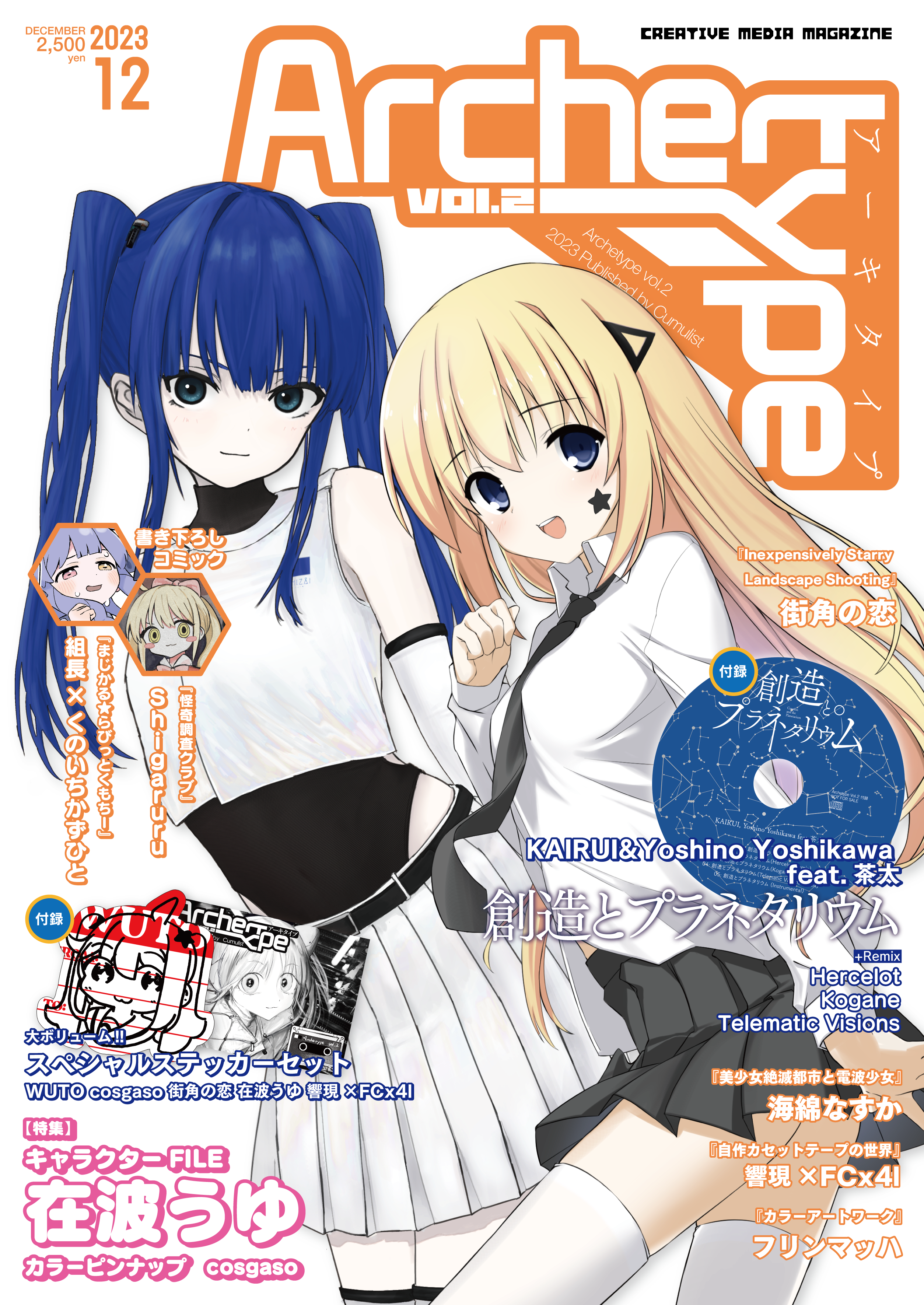
Cover featuring an illustration by cosgaso (right) and machikadonokoi (left), click image to see the CM released on YouTube
We'll first go over the where, who and when the magazine entails. Since I assume that most of you we're able to experience 2023 first hand, even if not under the lense of 2020s Otaku culture which I'll examine further as this post goes on, I'll start with where it released, as said above that would be the Comitia 146.
The Comitia started back in the 80s, a convention with a simple premise: only allowing sale of original works/doujinshi at various locations in Japan. It's 146th incarnation being the place where the second volume first saw the light of day at a little vendor stand. As a consequence all content of the magizine is original beginning with the cover featuring the OCs of the respective artists (being used as their pfps even), later featuring manga not based on any preexisting work and cumulating in the CD bundled.
While we should now have a tenous grasp of where it released, we still don't know who did. For that reason I'll now talk about the cumulist circle and its seemingly sole member cosgaso.
Cosgaso has a portfolio featuring a variety of illustrations and graphic designs made for their own magazines published under the cumulist circle or, as is mostly the case, comissioned for various artists, events or publications in the Japanese underground music scene. Their art has a distinct moe sensibilty that harkens back to the anime and VNs of the early 2000s until around the mid 2010s, while still feeling ddistinctly modern and polished with it being more subdued and bright in its colour palette. There are other artists who share these artistic sensibilities, as does Kokamumo for example. While interesting, I won't try to proclaim an artiistic genre in this post; we should instead be moving on toward the content we seek.
Content
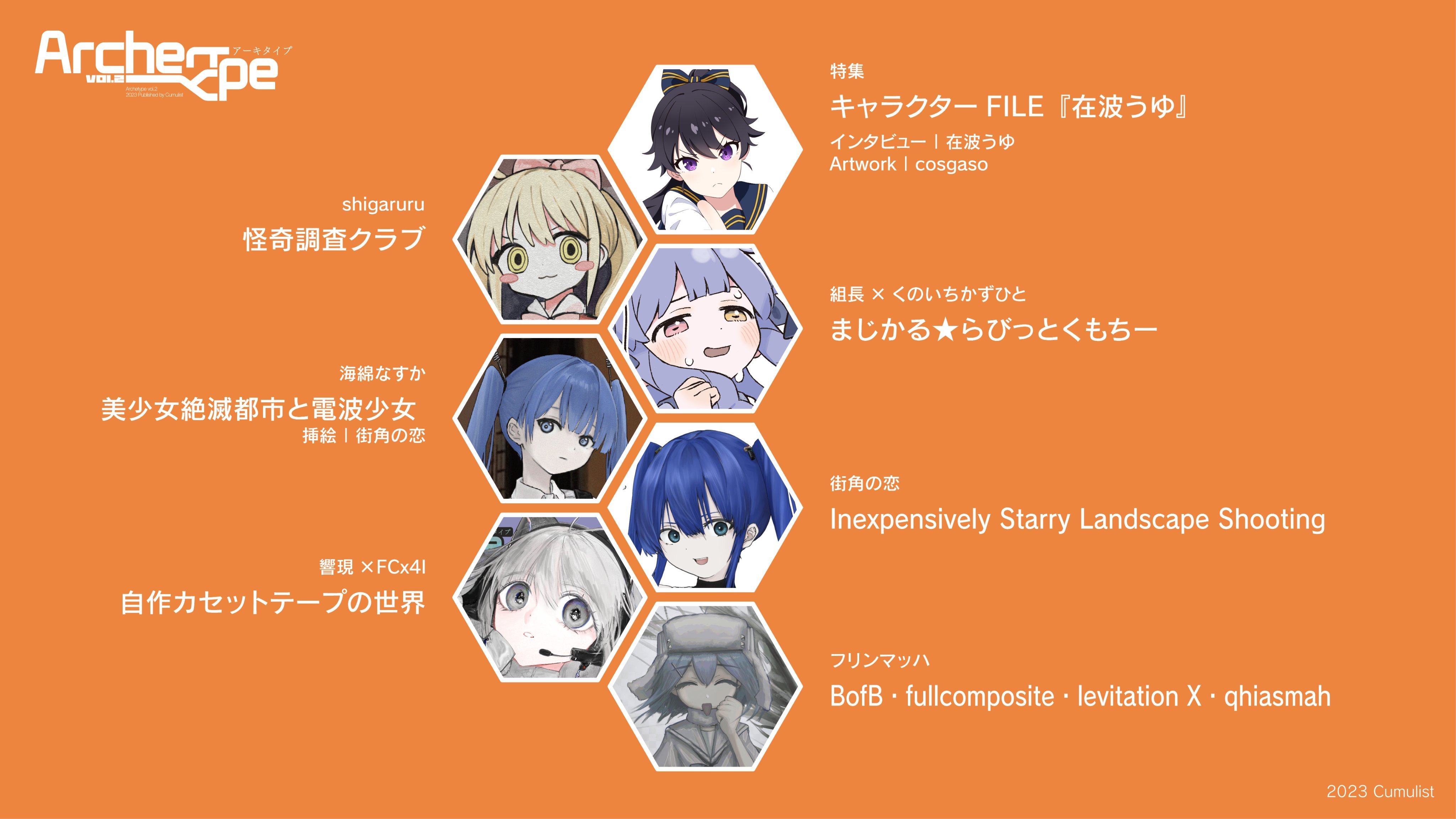
The table of contents as seen on the booth page
While the picture above unfortunately is incomplete we can still make use of it and create a table of contents:
- Character file: Alpha Uyu
- Bizarre Investigation Club - by shigaruru
- Magical Rabbit Kumochy - by Kumichou and Kunoichi Kazuhito
- The Bishoujo Extinction City and the Denpa Girl -by Kaimen Nasuka/nazca
- Inexpensively Starry Landscape Shooting - by Machikadonokoi
- The world of self made tapes - by Kyougen
- BofB fullcomposite levitation X qhismash
- Appendix Information
- Creator Profile
Character file: Alpha Uyu
Across the Tokyo area stickers are placed featuring a character named Alpha Uyu of the "Tokyo Fuuki " or roughly translated the "Tokyo Fuuki/Moral Comittee". As Alpha Uyu is presented as their president she has design elements commonly associated with her role as seen in various school anime, such as an armband with the Kanji "Fuuki" printed on it and an overall charismatic, authoratative demenour. Some stickers have the catchphrase "Dame yo, zettai!" on them, meaning something along the lines of "Absolutely, don't do it!". One may wonder what all of this is about but it's best understood as an art project as the social media accounts show an affinity toward street art and the "comittee" does have it's own galeries set up garnering the attention of other outlets. The first article is an interview with her, or rather the artist responsible
The interview itself is a bit short spanning only one page and mostly features small questions and their answers, much can be inferred by the little introduction I give at the beginning, however there are still cute bits of additional information. That being listening to the music of Nujabes while walking for example or that she's made many friends overseas since starting her activities and wants to lay eyes on various countries. It even features her favourite places of Tokyo which include the ever famous Akihabara and Harajuku but also Nakano and Hachiouji. At the end she tells the reader that she'll do her best keeping morals in check even now, befitting her character.
The manga: Bizarre Investigation Club and Magical Rabbit Kumochy
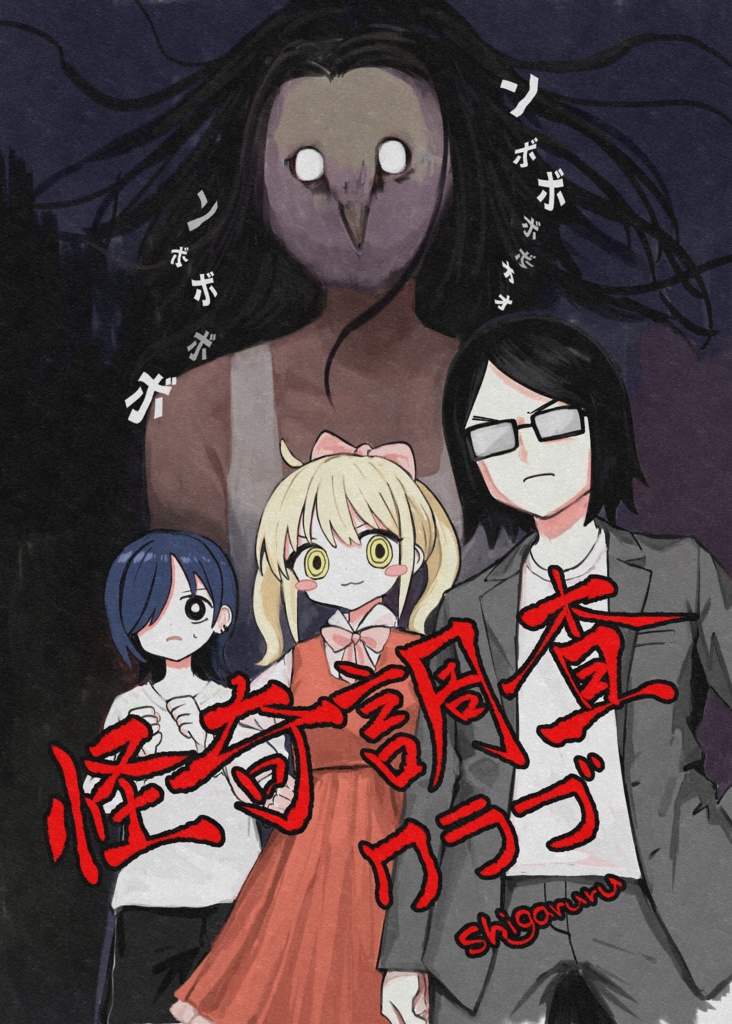
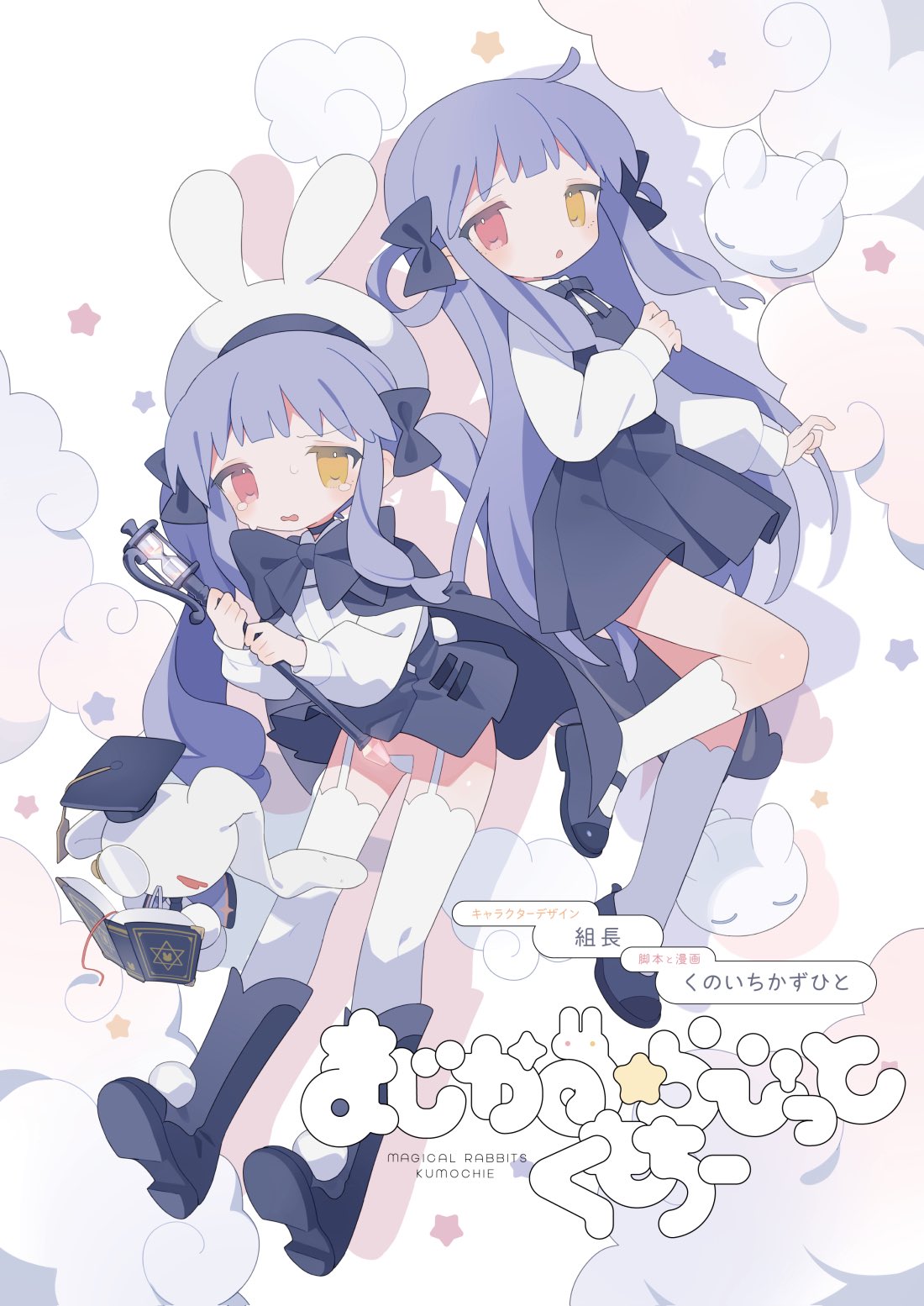
Cover pages of the manga: Bizarre Investigation Club on the left, Magical Bunny Kumochy on the right
I will only skim over the manga because I don't want to give a summary here which would in turn kind of defeat the purpose of reading them in the first place. In fact you can buy the first manga "Bizarre Investigation Club" digitally on booth but this sadly isn't the case for "Magical Rabbit Kumochy", there only is a sample provided on Twitter/X. If you want to read a self-published mystery manga with a price of 300yen however, and are able to do so in Japanese, now is your chance.
Unfortunately, I can't say much about the author of "Bizarre Investigation Club", that being shigaruru. They seem to be pretty active when self-publishing manga as this is most of their output. Paintings and illustrations by them also are available though, which do fit the modern moe artstyle I've been writing about some paragraphs earlier but otherwise they did attend the Comitia a couple of times in order to sell their manga.
While Magical Rabbit Kumochy isn't available outside the magazine it is confined in, I can say that it is a magical girl-esque series about a girl caring for rabbits and the hijinks she faces after transforming and even beforehand. The character design is provided by Kumichou and the manga is authored by Kunoichi Kazuhito who has most notably been involved in an anthology manga for Needy Streamer Overdose, a series Kumichou did design merch for by the way, and another one for Blue Archive (Blue Archive is very popular among Japanese Otaku audiences making up a sizable chunk of the last few Comiket, NSO is more niche but still has a solid standing over there and can be put in the wider context of denpa works that it was influenced by, as did Sayooshi for example, and represents by association). Credited neither in the table of contents or the magazine itself where the designer of the title logo Hiroi Hakumai.
Kumichou's character design and Kunoichi Kazuhito's artwork show a distinct avoidance of sharp edges and opt for an artstyle TV-tropes describes as Puni Plush, whith the characters having the disctinct childlike appearance this entails. A well-known example of this artsytle also being "Lucky Star". This should be all I can saw about these two titles currently :/
At the end of the manga there also are a few additional pages though that mostly just serve as character showcases for Magical Bunny Kumochy.
The Bishoujo Extinction City and the Denpa Girl
Following the manga an essay by Kaimen Nasuka takes stage. Nasuka, more well known under the online alias nazca, is leader of another doujin circle called "Moeken" which is a shortening of their previous name "Osaka Daigaku Moe Kenkyuukai" loosely translating to "Osaka University Moe Research Club" also publishing the moeroot magazine which I'll take a look at after I finished this article. As their full name might make you believe the essay is about Osaka or more specifically the Nipponbashi area, not to be confused with the Nihonbashi bridge written in the same Kanji. Nipponbashi is a place similar to Akihabara in that it is a gathering place for Otaku interests, featuring a melonbooks store, an Animate store, a Surugaya etc. I even took a look at in Google street view just to get more insight and saw a maid cafe in a brutalist building which sure is something but I can attest that Otaku interest lay at its centre.
In commederation nazca wrote a post on their blog announcing the essay adding context to this whole section and praising the magazine for its cool songs, lovely collaborators and cute illustrations which honestly has been a pretty wholesome read. Further insight into the Nipponbashi area is also given beginning with asking the reader if they've ever been there and saying that it's a nice place and describing it more thoroughly. We should now be able to take a look at the essay itself.
The first lines set the stage by describing the area I've described above, notably commenting on the apperance of K-Books, an used books store in the vacinity with a billboard that may be well past its prime with fading ink, set up back when the store first opened back in 2004.
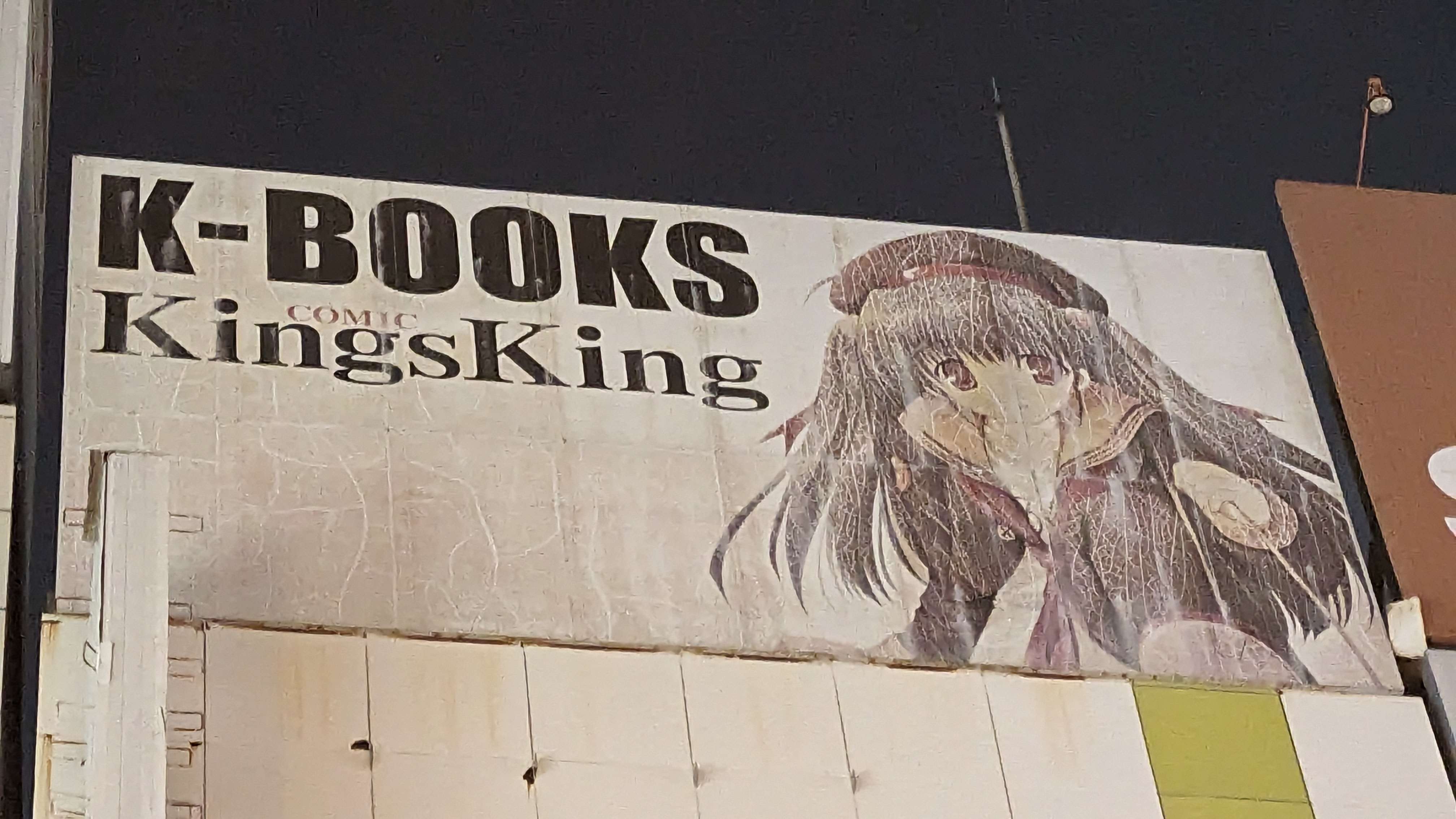
The afforementioned billboard
As the essay goes on, making observations about the girls, may they be Dejiko or any other mascot, on these signs and how they slowly get fazed out, in Osaka that is, positing however they still are eternal as they live on in the imaginations of the onlookers. Describing the setting further, other billboards are showcased which lack the usual moe characters and cumulating in an exchange between author and character which is elaborated on in the comment as happening by electromagnatic radiation (this surprisingly is how the term denpa got its meaning to begin with). The moe mascots are described as stars, a comparison that leads into the next section thematically.
Inexpensively Starry Landscape Shooting
If you ever wanted to take a photograph of the night sky this might be the section for you. To be fair I don't really know if all of the advice apllies to places outside Japan but I'm pretty sure that one can rent all the equipment elsewhere.
Authored by Machikadonokoi, whose art we saw on the cover, the pages that follow are about the very thing that give this section its title. Giving the reader an instruction on how to photograph the night sky with proper equipment without losing all of their money doing so based on the author's personal experience. Peppered in are some cute illustrations that accompany the text.
The guide is devided into various sections, the first one discussing how smartphoned and their evolution lead everyone to have a camera that may be well enough to take pictures at night. These advancements however are not limited to smartphone cameras and swept over into mirror lense cameras for examples their price being the only hurdle with figures provided in the article ranging from 150 thousand to 300 thousend yen. To facilitate the high prices one can order cameras online on auction sites or other storefronts. A list of equipment used by Machikadonokoi in their endavours is also provided, however I could not find information about their price other than that it may be less expensive buy a substential margin.
The next sections mostly focus on the process itself and show some examples too and recommend to rent equipment too if that it is possible to save more money in another paragraph. Other than that it provides suggestions on what to look out for in the sky and therefore photograph, where you can get better pictures and how you can process them afterwards.
The world of self made tapes
The last long form text is provided by music artist Kyougen who has worked with Netlabels or other underground labels. This naturally leads to a neccesity to release their music physically which they've done themself on casette tapes.
Reasons are provided for why one should endulge in the endavour of recording cassete tapes which the article does provide in a small section. The reason being a revival of records and tapes in a crowd willing to support the artist buy buying their merch, even if streaming services get increasingly popular and are the default way of music publication nowadays. The reason as expressed probably being a personal one.
The following paragraphs mostly serve as an instruction of sorts. There is a list of equipment provided which one may need if they want to start and it goes more in depth than needed for a layperson with guides on how you can put artwork on the cases if you need to so.
The article ends with a page showing the covers of Kyougens albums which were released at the year of the magazines publishing 2023, some of which are bandcamp releases I'll embed here. My personal favourite may be the second one which is a showgaze compilation with one track by them but it overall is a pretty nice listen. Besides, I can also add that they do seem to be a fan of anime classic Serial Experiments Lain.
Some albums by Kyougen, as showcased at the end
A picture collection, additional information and the extras (content 7-9)
The last pages of the magazine are occupied by and collection of illustrations by Furinmach whose personal webpage probably describes their artstyle better than I ever could.
Following the illustrated pages are the last paragraphs of text spread out at around three pages providing additional information and describing the extras that came with the magazine. The centrepiece being the bundled CD featuring a track by Kairui and Yoshino Yoshikawa sung by Chata and various remixes that come together to form an EP which you may listen to with the Spotify embed link I provided. Chata herself actually is sort of a renowned figure in the Doujin music scene to my knowledge. The PV I provided at the beginning actually emphasizes her involvement as singer with saying bewilderdly "The vocals are by Chata?!" and otherwise she has sung some songs for Taiko no Tatsujin such as "Yuujou Pop". Kairui is a friend of cosgaso and as is the case with most artists here active in the underground music scene.
At the end stickers get showcased which I sadly haven't gotten with my edition but they do include an Alpha Uyu Archetype sticker which is pretty cute and fits its mofif. The last page provides information about all people involved and their Twitter/X handles together with little blurbs, ultimately closed off by a back cover provided by Kumichou.
Conlusion
As this is my first blog post there are things I'd like to improve in the future and I think this post could have been far better made overall since I haven't provided any pictures of the pages. But I may still add them someday or make a revised version of this post alltogether. I think the latter sections especially lack in quality since I kind of rushed through them but I hope that'll get better next time.
Anyhow, the Archetype magazine has a wide range of content ranging from art, manga, essays and music. All of the content sharing a distinct passion for some kind of DIY ethos with a sincere passion, dressed in a simple clean layout which may still differ depending on the article. This probably is due to its origin at a convention actively promoting this kind of mindset and the whims of the publisher but it's inspiring nonetheless.
There will come a time I take look at a magazine again but I at least hope you had some fun reading! Until then, I hope you'll have a nice time! :D